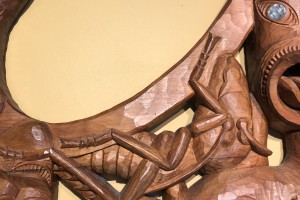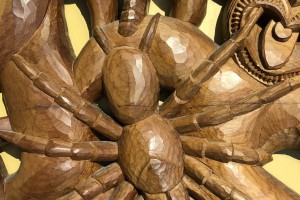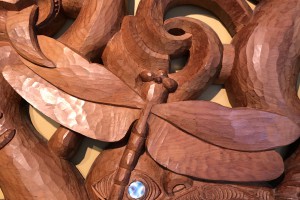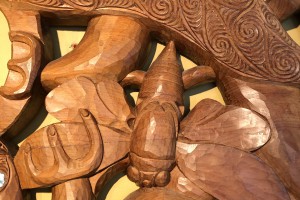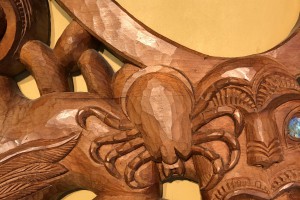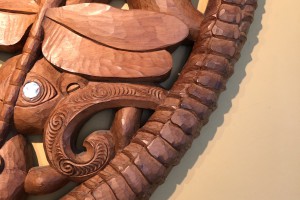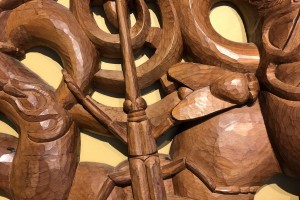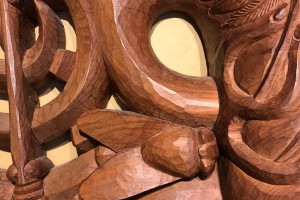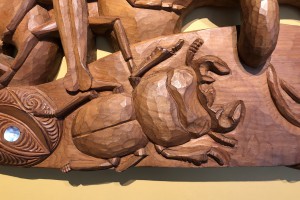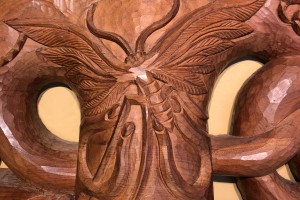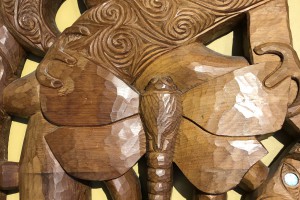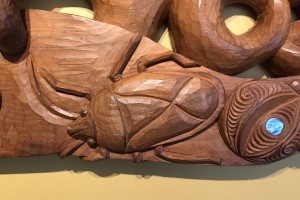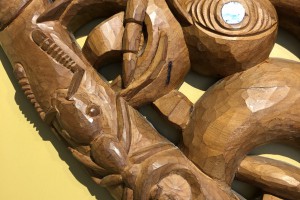The arthropods on the pare
The pare, or carved door lintel, that stands over the entrance to the New Zealand Arthropod Collection (NZAC) / Ko te Aitanga Pepeke o Aotearoa at Manaaki Whenua in Auckland.
About the pare
- is 1.5 x 0.9 m in size;
- was carved from recycled kauri wood over 100 years old, salvaged from a former coolstore shed at the Port of Auckland in the 1980s;
- was carved in the style of Ngāti Whātua of the Auckland/Tāmaki Makaurau region by Mr Denis Conway, a student of the late Henare Toka;
- is over the main doorway entrance to the NZAC insect collection, and was dedicated on 13 February 1990; is unusual in having insects and their relatives (arthropods) depicted on it.
Activities based on the pare
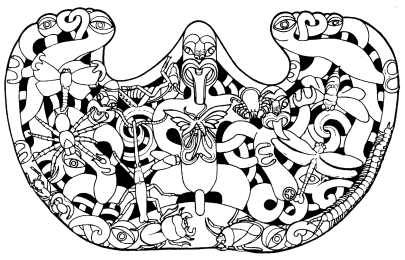
Pare outline - click to download
- Make a key to identify the arthropods on the Pare:
- number each arthropod with a unique number;
- make a list of those numbers;
- print the name of each arthropod against its unique number.
- Colour in the arthropods. Perhaps use different colours for different Orders or Classes of arthropods.
- Colour in the manaia. The central part of each eye is made of paua shell.
- Draw an arthropod.
Activities based on the Pare information
- Spelling challenge: choose a word from the information with each arthropod and learn to spell it. Write a sentence using the chosen word.
- Word-making challenge: choose a word and make a list of words you can form with the letters in that word.
- Geography challenge: locate the New Zealand place names and the offshore islands mentioned.
Questions based on the Pare
Arthropods
- How many animals (arthropods) are there on the pare?
- How many arthropods are on the left and right of the central manaia? (Is this different to what you see as left and right?)
- How many insects are there?
- How many arthropods are there that are not insects?
- How many legs do the spider and mite each have?
- How many legs do the beetles each have?
- How many wings does the blowfly have?
- How many wings do the other insects have?
- How many spines are there on the hind leg of the wētā?
- How many segments does the centipede have?
- How many arthropods have their heads facing the:
- top
- bottom
- left
- right
- none of these?
- How many arthropods have their bodies oriented more than 20° from a horizontal or vertical line on the pare?
Manaia (figures)
- How many manaia are there on the pare?
- How many eyes can be seen?
- How many manaia have 1 eye only?
- How many tongues are there? Describe their shapes.
- How many fingers and toes are there on each limb of a manaia?
- What is the total number of fingers and toes?
- What is the total number of fingers and toes with nails?
Scientific names
- Animals and plants are given a scientific name when they are formally described by scientific researchers.
- The scientific name consists of a Genus name and a species name, usually written in italic type.
- The Genus name has a capital first letter, whereas the species name is all in lower-case letters.
- All organisms are classified in a hierarchial system indicating the degree of relationship between them.
Classification of the arthropods on the Pare
The 13 organisms on the Pare are classified into 10 Orders in 3 Classes of the phylum Arthropoda as follows:
- Phylum: Arthropoda (which means "jointed limbs")
- Class: Insecta (insects)
- Order: Coleoptera (beetles)
- Order: Diptera (flies)
- Order: Hemiptera (true bugs)
- Order: Hymenoptera (wasps)
- Order: Lepidoptera (moths and butterflies)
- Order: Odonata (dragonflies)
- Order: Orthoptera (grasshoppers, wētā)
- Class: Arachnida (mites, spiders)
- Order: Acari (mites)
- Order: Araneae (spiders)
- Class: Myriapoda (which means "many limbs"; the centipedes and millipedes)
- Order: Chilopoda (centipedes).
- Class: Insecta (insects)

